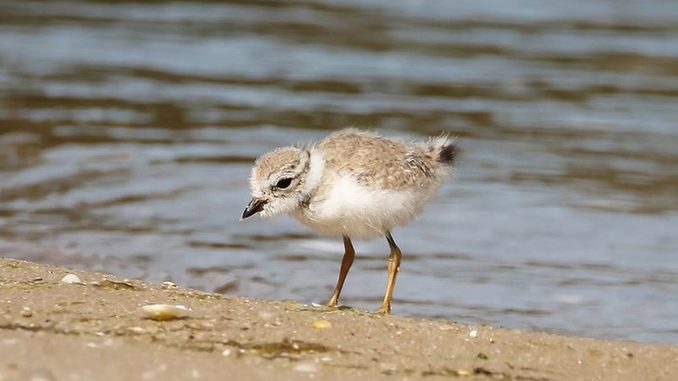
The North Fork Audubon Society released its 2022 Town of Southold Nesting Shorebird Report, detailing the activity of six species of threatened and endangered shorebirds along the North Fork along with recommendations on how the community and officials can limit disturbances to nesting sites.
This year’s report, written by the society’s Jennifer Murray, monitored 22 nesting site locations, both active and inactive, from March through August. While active sites were monitored closely, approximately three times per week, inactive sites were checked three times throughout the nesting season.
“In general, fledgling rates are higher,” said Audubon Society treasurer Theresa Dilworth. Three of the threatened species — piping plover, least tern and American oystercatcher — saw increased numbers of fledglings compared to the previous two years.
Mattituck Inlet serves as a key nesting and foraging location for shorebirds. Breakwater Beach in Mattituck was one of the most productive nesting sites on the North Fork this year, according to the report, with six piping plover pairs nesting within a quarter-mile of each other. Approximately 15 pairs of least terns were observed nesting west of the Breakwater jetty.
“Historically, there has been a colony of 50-100 least terns [at the jetty], but since the coronavirus in March of 2020, recreational fishing has dramatically increased, inadvertently decreasing the least tern population,” Ms. Murray wrote in the report.
Of the nest disturbances at the 22 locations surveyed, the majority were human-caused. Mattituck Inlet beaches received an increasing number of disturbances, the report states. Disturbances included off-leash dog walking, ATV use, beach raking to rid the shoreline of seaweed and reeds, beach bicycle usage, fishers entering fenced areas, trash collection and camping near areas enclosed by symbolic fencing. Westernmost piping plover nests received the most significant disturbances, according to the report.
In order to protect the Mattituck Inlet site, The North Fork Audubon Society recommended the Mattituck Park District consider allowing the entire jetty area to be fenced off symbolically to deter fishers and beachgoers from entering nesting sites. Improving dog-walking restrictions, posting informational signage and discouraging bonfire parties at Bailie Beach are recommended as well. Private landowners near Breakwater Beach and the surrounding neighborhoods are encouraged to avoid beach raking, ATV use, illegal fireworks and off-leash dogs during the shorebird season.
Nesting areas at Goldsmith Inlet in Peconic, Southold Town Beach, McCabe’s Beach and Kenney’s Beach, saw near record numbers of least terns this season. Twenty pairs of least terns produced approximately 25 fledglings. However, to improve the nesting successes of least terns and piping plovers, the Audubon Society encouraged property owners, beachgoers, fishers and dog walkers to increase their awareness through posted educational signage and participating in outreach events in order to improve the success of both species in the area.
Areas such as Richmond Creek, Little Creek, Goose Creek and Gull Pond saw successful numbers for piping plover and least tern nests. All share similar disturbances, most of which are human-caused; however, these locations also note the presence of wildlife and natural disturbances, typically in the form of predators and flooding.
The usual recommendations to limit man-made disturbances and increase shorebird nesting at these locations are listed in the report, along with the proposal to install trail cameras to document predators, with the landowner’s approval. At Gull Pond, a few beachfront owners agreed to fence their properties in 2023 to further protect nesting shorebirds.
A colony of over 60 great black-backed gull nests was documented on the island across from Port of Egypt Marina. Species such as least tern, Common Tern and American oystercatcher also had successful nests in the area. The high volume of boating traffic is cause for future concern, but did not seem to affect the shorebirds nesting this season, according to the report.
Conkling Point in Greenport experienced unusually high tides this season; however, one pair of piping plovers was able to successfully nest. Piping plover and least tern both abandoned nesting sites at Cutchogue Harbor while a pair of American oystercatchers experienced nest failure, most likely due to raccoons.
While inactive sites such as Downs Creek in Cutchogue and Hashamomuck Beach in Southold saw no change due to wildlife disturbances and erosion, Corey Creek in Southold had a small colony of least terns arrive around late June or early July. The nests were discovered during a check of inactive sites, but because the least terns were at the end of their nesting season, no symbolic fencing was placed. The Audubon Society recommended the installation of symbolic fencing next season along with informational signs to educate beach and dog walkers in the area. The Audubon Society believes that Corey Creek could be an active nesting site for piping plover if fencing were to be installed.
The report ended with ideas on how the Town of Southold could further protect shorebirds. Working with the police department on active beach violations during nesting season is one recommendation, along with “partnering with private property owners, environmental organizations, and [New York] State and Suffolk County Parks to create public outreach programs discussing shorebird conservation and protection,” the report states.

